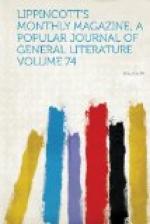Although one commences at eight o’clock on the bills, one does not commence in reality at any such unfashionable hour. If we are so innocent as to go to the ball-room before ten o’clock, we shall find only a crowd of boys and girls gathered about the entrance of the hall, waiting to see the guests arrive. Needless to say, no carriages roll up to this door. The revelers come on foot, emerging from dark alleyways, descending from garrets by creaking old staircases, filtering out one by one into the street, and making their way to the ball-room in couples or alone. To find the ball in the full tide of successful operation we should arrive about half-past ten in the evening. Entering then through a long, broad passage, midway of which we deposit five sous each with the Cerberus on guard, we pass into a hall crowded with people. The hall is not larger than that of an average country-tavern ball-room in New England: the space occupied by the dancers will accommodate perhaps fifty quadrille sets. (There are no “side couples” in the quadrilles of Paris popular balls; hence a set consists of but four persons.) This would indicate a pretty large ball-room to most minds, but the dancers here are crowded so close upon each other that they really occupy a surprisingly small space.
Up and down the two sides of the long hall are ranged coarse wooden tables, with the narrowest benches at them for use as seats that I think ever served that purpose. Sitting on a Virginia fence is the only exercise I remember that suggests the exceeding narrowness of the benches at the ragpickers’ ball. On the side of the tables nearest the wall runs a narrow alley, down which we walk in search of a seat. On the other side the tables are protected from the dancers—who might otherwise bang destructively against them, to the detriment of wine-bottles and glasses—by a stout wooden railing. Reaching the lower end of the hall, we find an unoccupied seat, and are able to survey the scene at our leisure.
The hall is lighted by no fewer than six chandeliers, with numerous burners, and between the chandeliers depend from the ceiling large glass balls, coated inside with quicksilver, which serve to reflect the light and add something of brilliancy. There are two round holes for ventilation in the ceiling: the only windows are two which are at the lower end of the hall, and look out on a gloomy courtyard surrounded by a high wall, on whose ridged top is a forbidding array of broken bottles imbedded in the mortar. On an elevated platform at one side, as high as the dancers’ heads, sits the orchestra “composed of artists of talent,” thirteen in number; and it is but justice to say that they make excellent music—far better than that we commonly hear at home in theatres and at dancing-assemblies. Blouses are abundant on the floor, in spite of the fact that the ball is advertised to be “dress, mask, disguise.” Near us is a dusty blousard in huge wooden shoes, who dances no less vigorously




